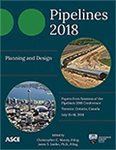Pipelines 2018
Understanding Pneumatically-Induced Hydraulic Surges and Geysers in Sewers
Publication: Pipelines 2018: Planning and Design
ABSTRACT
The need for urban sewers continues to grow due to numerous causes, such as population growth, climate change, and the desire to prevent sewage from discharging to the environment. To meet this need, many owners are installing tunnels as part of the solution. Surges and other transients, which are predominantly a wet weather feature, are more common in large-diameter sewers in deep tunnels than near-surface sewers. While the hydraulic drivers of surges and transients are well-documented and generally well-understood, the role of air in inducing these surges and geysers is less so. Pneumatically-induced hydraulic surges can result in geysers, which are violent eruptions of sewage that occur at the ground surface. These geysers can result in numerous potential health and safety concerns, such as damage to infrastructure, discharges of sewage to the environment, displacement of protective manhole covers, trip/fall hazards, etc. Through the use of real-world examples, this paper examines the causes and effects of pneumatically-induced hydraulic surges and geysers in sewers. The associated presentation includes several videos of real-world geysers, as well as modeling result animations from surges in tunnel systems. These videos and animations provide the practitioner with a solid grasp of the causes and effects of air in tunnel systems under wet weather events.
Get full access to this article
View all available purchase options and get full access to this chapter.
REFERENCES
Alves, G. E., (1954). “Chemical Engineering Progress,” vol. 50, pp. 449–456, 1954.
Baker, O., (1954). Oil Gas Journal, vol. 53, No. 12, pp. 185–190, 192, 195, July 26, 1954
Brocard, D., McMasters, F., and Thomas, D. (2012). “Air Flow in Sewers,” Proceedings of the Water Environment Federation Annual Technical Exhibition and Conference, 2012
Chan, S. N., Cong, J., and Lee, J. H. W. (2016). “Numerical Modeling of Geyser Formation by Release of Entrapped Air from Horizontal Pipe into Vertical Shaft,” 12th International Conference on Hydroscience & Engineering Hydro-Science & Engineering for Environmental Resilience, November 6-10, 2016, Tainan, Taiwan.
EPA(2004). “Impacts and Control of CSOs and SSOs.” Report to Congress EPA 833-R-04-001 United States Environmental Protection Agency Office of Water (4203), Washington, D.C. 20460.
Escarameia, M. (2007). “Investigating Hydraulic Removal of Air from Water Pipelines,” Proceedings of the Institution of Civil Engineers, Water Management 160, March 2007 Issue WM1, Pages 25–34
Guo, Q., and Song, C. S. S. (1991). “Hydrodynamics under transient conditions.” Journal of Hydraulic Engineering, 117, 1042–1055
Falvey, H. T. (1980). “Air-Water Flow in Hydraulic Structures,” U.S. Bureau of Reclamation, Engineering Monograph No. 41.
Huff, F. A. and J. R. Angel (1992). Rainfall Frequency Atlas of the Midwest (Bulletin 71). Illinois State Water Survey, pg. 49
Leon, A. S. (2017). “Mechanisms that Lead to Violent Geysers in Vertical Shafts.” Journal of Hydraulic Research. Under review. Accepted with minor revisions. R835187
Lewis, J. W. (2011). “A Physical Investigation of Air/Water Interactions Leading to Geyser Events in Rapid Filling Pipelines,” A dissertation submitted in partial fulfillment of the requirements for the degree of Doctor of Philosophy in the University of Michigan
Malekpour, A., (2014). “Analysis of Rapid Pipeline Filling Including Column Separation & Entrapped Air Effects,” A thesis submitted in conformity with the requirements for the degree of Doctor of Philosophy, Department of Civil Engineering, University of Toronto
Mortensen, J.D. and Kubitschek, J. P., (2016). “Effects of Hydraulic Jump Motion on Air Entrainment in Closed Conduits,” 6th International Symposium on Hydraulic Structures, Portland, Oregon, USA, 27-30 June 2016, Hydraulic Structures and Water System Management
Muller, K. Z. (2017). “Geysers Caused by the Sudden Release of Pressurized Air Pockets,” A thesis submitted to the Graduate Faculty of Auburn University in partial fulfillment of the requirements for the Degree of Master of Science.
National Weather Service (2017), Office of Climate, Water and Weather Services, http://www.nws.noaa.gov/om/hazstats.shtml
NOAA National Centers for Environmental Information (NCEI)U.S. Billion-Dollar Weather and Climate Disasters (2018). https://www.ncdc.noaa.gov/billions/
Rouhani, S. Z, and Sohal, M. S., (1983). “Two-Phase Flow Patterns: A Review of Research Results,” Progress in Nuclear Energy, Vol. 11, No. 3, pp. 219–259.
van Oldenborgh, G. J., van der Weil, K., Sebastian, A., Singh, R., Arrighi, J., Otto, F., Haustein, K., Li, S., Vecchi, G., and Cullen, H., (2017). “Attribution of Extreme Rainfall from Hurricane Harvey, August 2017,” Environmental Research Letters, Vol. 12, Published by IOP Publishing
Vasconcelos, J. G. (2005). “Dynamic Approach to the description of flow regime transition in stormwater systems.” A dissertation submitted in partial fulfillment of the requirements for the degree of Doctor of Philosophy in the University of Michigan.
Vasconcelos, J. G. and Leite, G. M. (2012). “Pressure Surges Following Sudden Air Pocket Entrapment in Stormwater Systems.” Journal of Water Management Modeling R245–04. www.chijournal.org"ISSN: (Formerly in On Modeling Urban Water Systems. ISBN: 978-0-9808853-7-8)
Vasconcelos, J.G. and Wright, S.J. (2011). “Geysering Generated by Large Air Pockets Released through Water-Filled Ventilation Shafts,” Journal of Hydraulic Engineering, 135(5): 543–555, 2011.
Vasconcelos, J.G. and Wright, S.J. (2012). “Mechanisms for Air Pockets Entrapment in Storm Water Storage Tunnels,” World Environmental and Water Resources Congress 2006.
Wikipedia Contributors (2018). “Sewer Gas,” Wikipedia, The Free Encyclopedia, 11-Jan-18, https://en.wikipedia.org/wiki/Sewer_gas
Wright, S. J. (2013). “Modeling Rapid Filling Processes in Stormwater Tunnels,” DSD International Conference 2014, Hong Kong, November 12-13, 2014
Zhou, F., Tsang, D., Hicks, F., Steffler, P., and Ward, C., (2001). “Pressure Oscillation Induced by Trapped Air in a Trunk-Shaft Sewer System,” 15th Canadian Hydrotechnical Conference of the Canadian Society for Civil Engineering, Victoria, British Columbia, Canada
Information & Authors
Information
Published In
Pipelines 2018: Planning and Design
Pages: 176 - 184
Editors: Christopher C. Macey, AECOM and Jason S. Lueke, Ph.D., Associated Engineering
ISBN (Online): 978-0-7844-8164-6
Copyright
© 2018 American Society of Civil Engineers.
History
Published online: Jul 11, 2018
Published in print: Jul 12, 2018
Authors
Metrics & Citations
Metrics
Citations
Download citation
If you have the appropriate software installed, you can download article citation data to the citation manager of your choice. Simply select your manager software from the list below and click Download.
